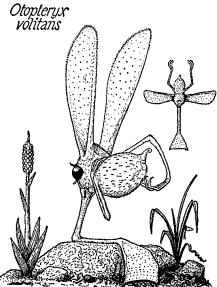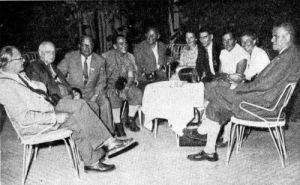Snouters (also known as Rhinogradentia or Rhinogrades or Nasobames) is a fictitious mammal order documented by the equally fictitious German naturalist Harald Stümpke.
Origin
Both the animals and the scientist were allegedly creations of Gerolf Steiner, a zoology professor at the University of Heidelberg. A mock taxidermy of a certain Snouter can be seen at the Musée zoologique in Strasbourg.
Description
The order's most remarkable characteristic was the Nasorium, an organ derived from the ancestral species's nose, which had variously evolved to fulfill every conceivable function over millions of years in the isolated Hi-yi-yi islands in the Pacific Ocean. All the 14 families and 189 known Snouter species descended from a small shrew-like animal, which gradually evolved and diversified to fill most of the ecological niches in the archipelago — from tiny worm-like beings to large herbivores and predators. Thus, most Rhinogrades used their nose for locomotion, the Sniffling Snouter caught fish with the long, delicate threads that emerged from its nostrils. The perfumed Honeytail Snouter stood rigidly upright on its thick nose and caught insects with its sticky tail. The Suctorial Snout Leaper used its long, flat nose to spring itself backwards great distances.
Story
The snouters were discovered on the main island of Hiddudify in 1941 by the Swedish explorer Einar Pettersson-Skämtkvist who was fleeing from the Japanese and became shipwrecked on the Hi-yi-yi Islands in the Pacific Ocean. The islands were also inhabited by the Hooakha-Hutchi people, the bizarre megaphone birds and an endemic shrew, Limnogaloides. A diverse endemic insect fauna was bizarre in including Palaeozoic relicts, and the flora also included archaic forms such as large clubmosses. Unfortunately, as a consequence of atomic bomb testing, the islands sank suddenly into the ocean in the late 1950s. Thus perished all traces of the snouters, their unique ecosystem, and all the world's specialists on that intriguing subject (including H. Stûmpke himself)— who happened to be holding their congress there at the time.
References
Snouters received their first and only scientific description in a monograph, Bau und Leben der Rhinogradentia, published in 1957 by the German naturalist Harald Stümpke. Another early reference to them is found in Christian Morgenstern's poem Das Nasobem (The Nasobame, 1905). The Great Morgenstern's Nasobame (Nasobema lyricum), a dog-size animal that walked on four snouts, was named in his honor.
- Dr. Harald Stümpke. The Snouters: Form and Life of the Rhinogrades. Translated by Leigh Chadwick. The Natural History Press (1967).


